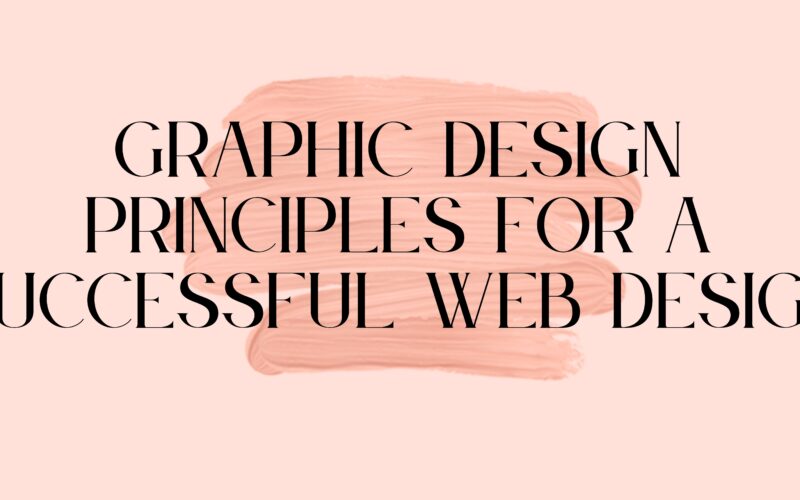The internet has become a place where people share and consume massive amounts of Graphic Design information. But the websites that really resonate with their visitors are those that use good design.
Building a website isn’t just about putting information into a box; it’s about structuring and organizing content in a way that is meaningful and useful to the user. A lot of people don’t realize this, but it’s what makes them stay on a website — or leave it in frustration.
In this article, we’ll be discussing the basic graphic design principles that can help make your website more effective.
Good graphic design is about more than just nice-looking images, colors or logos. Visual aesthetics are a large part of what makes up the best designs out there, but there are also many different aspects to be considered: from function to communication and technology. What principles should a designer follow?
Should they always follow them? And where do these come from in the first place? These questions and more will be answered in this post as we delve into the principles of graphic design – both basic and advanced – that you need to consider when designing your website.
Principles of graphic design:
Balance
Balance is a principle of art that refers to the distribution of elements in an artwork. It is achieved by arranging elements (line, shape, texture, color and value) to create a feeling of visual equality. Balance creates the sense that all areas of a design are equal in importance.
There are two types of balance: symmetrical (formal) and asymmetrical (informal). In symmetrical balance one side is a reflection or mirror image of the other. This type of balance usually suggests tradition or formality. In asymmetrical balance, objects are placed on either side of an imaginary line but they differ in size or importance. Asymmetrical balance usually appears more casual and less rigid than symmetrical balance.
Balance can be thought of as a system that distributes visual weight evenly throughout a design, so no part looks more important than any other part. Balance gives a sense of order and structure to graphic designs.
Hierarchy
The visual hierarchy is a concept in graphic design that determines the order in which people see objects. The visual hierarchy can be achieved through font size, contrast, color, placement and other elements of design. A visual hierarchy helps users understand what information is most important on webpages, landing pages, blog posts and other digital marketing materials.
It is an efficient way to organize content, making it easier for users to scan and find relevant information while they read.
Alignment
The alignment principle for graphic design is a way to make sure that your overall design looks clean and organized. Let’s take a look at how the alignment principle works.Alignment is what keeps the elements of a design or composition arranged along an imaginary line in a balanced and organized fashion.Understanding the alignment principle will help you create visual order in your designs, making them easier to read and understand. This will result in a more professional-looking presentation and give your work credibility.
Repetition
It is a fundamental principle of design and one that can be applied to any part of a design. It can be used to help unify your layout, create rhythm, establish dominance for specific items, add balance to asymmetrical layouts, and more.
Repetition is defined as the “action of repeating something that has already been said or written.” In graphic design, it is the repetition of elements in a piece. When done effectively, it can help create visual interest and make the design stronger.
When designing a page or document, using repetition will help unify the individual pieces and make them work better together.
However, not all repetition is good – if you repeat too much you will have a monotonous piece and it will feel boring.
Proximity
The proximity principle is a guideline in visual design that says every element near each other should be related to one another. This rule helps the designer group related items together.
How does this work? The closer elements are together, the stronger the relationship.
For example, think about what happens when you rearrange the letters of “PRINCIPLE”:
PNCERLIPE — Visual nonsense. “PNCERLIPE” doesn’t make sense because it’s hard to find any relation between these letters.
PRNCEILPE — Better but still not good enough. “PRNCEILPE” makes more sense than “PNCERLIPE,” but there’s still no sensible relation between letters.
PRINCIPLE — Yes! Now we have a word! The proximity principle in action!
Rhythm
Rhythm is a design principle that refers to the regular or progressive recurrence of specific elements in a design. It is a concept that can lend itself to both the organization of design elements (such as in typography or iconography) and the pacing of the user experience (such as timing and motion).
The rhythmic quality of a design can be used to create an engaging visual experience, so that users will want to continue interacting with it.
There are two main types of rhythm:
Regular rhythm: based on repetition and uniformity
Fluid rhythm: based on irregularity and movement
There are also three main types of pacing:
Slow: simple and obvious, easy to understand, conservative, ideal for complex information
Fast: intense, exciting, dynamic, ideal for simple information
Variable: unpredictable and random, ideal for creating surprise

